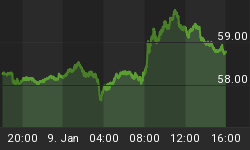It is the general view that the U.S. economy has outperformed the rest of the world in the past several years. Judging by real GDP growth rates, this is true. Yet the reason why is obvious, easily explained, and disastrous in its consequences: the U.S. credit machine has no parallel in the world. It is geared to accommodate absolutely unlimited credit for two purposes - consumption and financial speculation.
There has developed a tremendous and growing imbalance between the huge amount of credit that goes into these two uses and the minimal amount that goes into productive investment. Instead of moving to rein in these excesses and imbalances, the Greenspan Fed has clearly opted to sustain and foster them.
Today it is customary to measure economic strength by simply comparing recent real GDP growth rates. It always becomes fashionable when U.S economic growth is higher than in Europe.
From a long-term perspective, however, economic policy and economic growth are about physical resource allocation, that is, available tangible capital stock and labor. How much of the current production is devoted to consumption and how much to capital investment? Looking for economic health and strength, generations of economists have focused on two economic aggregates: savings and investment, in particular net savings and net investment.
It used to be a truism among economists of all schools of thought that the growth of an economy's tangible capital stock was the key determinant of increased productivity and subsequently of good, high-paying jobs. And it also used to be a truism for economists that from a macroeconomic perspective, tangible capital investment into factories, production equipment, and commercial and residential building represents the one and only genuine wealth creation.
But in America's new money culture, policymakers and economists make no difference between wealth created through saving and investment in the real economy and wealth created in the markets through asset bubbles, engendered by extremely loose money and credit.
In 1996, an article in Foreign Policy entitled "Securities: The New Wealth Machine," explained how securitization - the issuance of high-quality bonds and stocks - has become the most powerful engine of wealth creation in today's world economy. Whereas societies used to accumulate wealth only slowly, they can now do so quickly and directly, and "the new approach requires that a state find ways to increase the market value of its productive assets." In such a strategy, "an economic policy that aims to achieve growth by wealth creation therefore does not attempt to increase the production of goods and services, except as a secondary objective."
This a perfect description of the corrupted economic thinking that is today ruling in America not only in corporations and the financial markets, but even among policymakers, elevating wealth-creation, that is, bubble-creation, to the ultimate of wisdom in the policy of economic growth.
There can be no question that the rapid sequence of asset bubbles - stocks, bonds, housing - that the United States has seen in the past few years were crucial in stimulating economic growth. Considering, though, its tremendously lopsided effect on consumer spending and the associated consumer-borrowing orgy, we are unable to regard this as a reasonable and sustainable policy. It works in the short run from the demand side, but it has come at heavy structural costs.
With these remarks, we wanted to make one thing perfectly clear. It is not profits, savings and investment that drive U.S. economic growth. It is America's unparalleled credit machine, and that alone, which makes all the difference in economic growth and wealth creation between America and the rest of the world.
In the consensus view, the U.S. economy is breaking out of its anemic growth pattern. A few signs of accelerating economic growth have led to this forecast, in particular the 8.2% spurt of real GDP growth in the third quarter of 2003 and within it sharply higher investment technology spending, up 22%; surging profits, and also surging early indicators, among them in particular the November ISM survey for manufacturing. Various indicators are at their strongest in 20 years.
We strongly disagree with this assessment. The growth spurt in the third quarter was exceptional, due to a one-off splurge in tax rebates and a burst in the mortgage refinancing wave. As to investment spending, what essentially matters is the change in total nonresidential investment, and that continues to show virtual stagnation. The widely hailed surge in IT investment came overwhelmingly from the hedonic pricing of computers, which has been abolished. Recent profits reports have indeed been impressive, but their success is vastly different between sectors and not as straightforward as the official numbers imply.
Yet our disbelief in the U.S. economy's breakout from its protracted sluggishness has one main reason: All the economic growth of the past two years, anemic as it was, is traceable to a seemingly endless array of asset and borrowing bubbles. Quoting analyst Stephen Roach, "the Fed, in effect, has become a serial bubble blower" - first the stock market bubble; then the bond bubble; then the housing bubble and the associated mortgage refinancing bubble. As a result, consumer spending has been surging well in excess of disposable income for years.
The idea was that sustained and rising consumer spending would in due time stimulate investment spending. It has grossly failed to do that. Our assumption rather is that consumer spending will slow as the asset and consumer borrowing bubble are sure to fade. Seeing no big investment recovery, we expect a surprisingly weak U.S. economy in 2004.
Regards,















